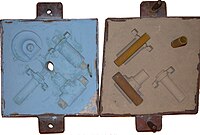
Photo from wikipedia
Abstract 3D printed sand molds for the casting industry play a vital role in manufacturing intricate parts using a computer model. The possibility of producing fairly significant structural castings using… Click to show full abstract
Abstract 3D printed sand molds for the casting industry play a vital role in manufacturing intricate parts using a computer model. The possibility of producing fairly significant structural castings using a small job-box 3D sand mold printer is another advantage compared to the direct metal 3D printing processes. It is important to identify the relationship between the process parameters and the properties of the sand mold to produce a mold with the required strength, permeability and stiffness; to reduce gas emissions during casting and minimize the mass of combustible materials in the mold. Hence, it is possible to create an excellent casting by improving the design of such molds for liquid alloy filling and solidification. The relationship between the printing parameters and the properties of the mold can be a great tool for foundrymen, primarily to optimize the strength and permeability properties of these molds and therefore to provide exact boundary conditions for the solidification simulation prior to a casting trial. This paper reports on a study of a basic outline to quantify the role of the sand mold printing process parameters, particularly the recoater speed and print resolution, on the mold strength and permeability, and their impacts on the anisotropic behavior of the printed sand molds.
Journal Title: Journal of Manufacturing Processes
Year Published: 2020
Link to full text (if available)
Share on Social Media: Sign Up to like & get
recommendations!